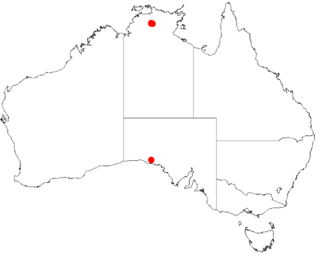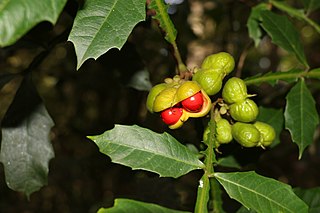
Dodonaea, commonly known as hop-bushes, is a genus of about 70 species of flowering plants in the soapberry family, Sapindaceae. The genus has a cosmopolitan distribution in tropical, subtropical and warm temperate regions of Africa, the Americas, southern Asia and Australasia, but 59 species are endemic to Australia.

Hoya australis, commonly known as waxflower or common hoya, is a species of flowering plant in the Apocynaceae or dogbane family and is native to northern and eastern Australia, Papuasia and Melanesia. It is a succulent vine or subshrub with fleshy or leathery, elliptic, oblong, egg-shaped or more or less round leaves, racemes of fleshy, cream-coloured and red flowers, and spindle-shaped follicles. It is a popular garden plant, noted for its fragrant flowers.
Dodonaea aptera, commonly known as coast hop-bush, is a species of plant in the family Sapindaceae and is endemic to coastal areas of the south-west of Western Australia. It is an erect to spreading shrub with simple, usually elliptic leaves, flowers arranged in cymes or panicles and more or less spherical capsules with four lobe-like wings.

Cupaniopsis newmanii, commonly known as long-leaved tuckeroo, is a species of flowering tree in the soapberry family and is endemic to eastern Australia. It is a rainforest tree with paripinnate leaves with 16 to 24 narrowly egg-shaped to elliptic leaflets, and separate male and female flowers arranged in panicles, the fruit a rust-coloured capsule flushed with pink.

Harpullia frutescens, commonly known as dwarf harpullia, is a species of flowering plant in the family Sapindaceae, and is endemic to North Queensland. It is a shrub with paripinnate leaves with 6 to 8 leaflets, white flowers with a pink tinge, and crimson capsules containing 2 seeds with a yellow aril.

Lepiderema pulchella, commonly known as fine-leaved tuckeroo, is a species of flowering plant in the family Sapindaceae and is endemic to coastal eastern Australia. It is a tree with pinnate, glossy light green leaves with four to fourteen leaflets, panicles of yellow-orange flowers and brown, spherical to three-lobed fruit.

Acacia argyrodendron, known colloquially as black gidyea or blackwood, is a species of flowering plant in the family Fabaceae and is endemic to Queensland. It is a tree with hard, furrowed bark, narrowly linear to elliptic phyllodes, golden yellow flowers arranged in racemes, and linear pods up to 120 mm (4.7 in) long.

Harpullia arborea, commonly known as Cooktown tulipwood in Australia, is species of flowering plant in the family Sapindaceae is native to the Indian subcontinent, Sri Lanka throughout Mainland Southeast Asia and Malesia to Queensland in Australia and the Western Pacific. It is a tree with paripinnate leaves with 6 to 10 leaflets, small pink or pale green flowers arranged in leaf axils or on old woody stems, and orange-yellow to red capsules containing shiny black seeds.

Acacia amanda is a species of flowering plant in the family Fabaceae and is endemic to a very restricted part of the Northern Territory. It is an erect shrub with narrowly elliptic or elliptic, leathery phyllodes, flowers arranged spherical heads of golden yellow flowers usually arranged in a raceme, and narrowly oblong pods 42–110 mm (1.7–4.3 in) long.

Harpullia alata, commonly known as winged tulip or wing-leaved tulip, is a species of flowering plant in the family Sapindaceae, and is endemic to eastern Australia. It is a tree with paripinnate leaves, the leaflets elliptic with teeth on the edges, white flowers and capsules containing a seed with a yellow to reddish aril.

Harpullia leichhardtii is a species of flowering plant in the family Sapindaceae, and is endemic to the Northern Territory. It is a tree with 4 to 8 paripinnate leaves, the leaflets oblong to elliptic, curved and papery, greenish-yellow flowers, and yellow-orange capsules.
Hibbertia hendersonii is a species of flowering plant in the family Dilleniaceae and is endemic to the Blackdown Tableland in Queensland. It is an erect shrub with densely hairy foliage, narrow elliptic leaves, and yellow flowers, each usually with twenty to thirty-one stamens arranged on one side of the two carpels.

Diploglottis harpullioides, commonly known as Babinda tamarind, is a rainforest tree in the lychee and maple family Sapindaceae which is found only in northeast Queensland, Australia.

Androcalva pearnii is a species of flowering plant in the family Malvaceae and is endemic to the Blackdown Tableland National Park in eastern Queensland. It is shrub that forms suckers and has hairy new growth, wavy, oblong to elliptic leaves with rounded lobes on the edges, and groups of 3 to 8 white and cream-coloured to pale green flowers.

Diploglottis bernieana, commonly known as Bernie's tamarind or large leaf tamarind, is a plant in the maple and lychee family Sapindaceae. It was first described in 1987 by the Australian botanist Sally T. Reynolds and is found only the Wet Tropics region of northeastern Queensland, Australia.
Cupaniopsis fleckeri is a species of flowering plant in the soapberry family and is endemic to northern Queensland. It is a small tree with paripinnate leaves with 8 to 10 elliptic to egg-shaped leaflets with the narrower end towards the base, and separate male and female flowers arranged in panicles.

Cupaniopsis serrata, commonly known as smooth tuckeroo, is a species of flowering plant in the soapberry family and is endemic to eastern Australia. It is a tree with paripinnate leaves with 6 to 12 oblong to egg-shaped leaflets with a pointed tip, and separate male and female flowers arranged in racemes, the fruit a more or less spherical capsule containing a seed with an orange aril.

Cupaniopsis simulata, commonly known as northern tuckeroo, is a species of flowering plant in the soapberry family and is endemic to eastern Queensland. It is a rainforest tree with paripinnate leaves with 4 to 12 elliptic leaflets, and separate male and female flowers arranged in a thyrse, the fruit a brownish orange capsule.

Cupaniopsis tomentella, commonly known as Boonah tuckeroo, is a species of flowering plant in the soapberry family and is endemic to south-eastern Queensland. It is a tree with paripinnate leaves with usually 6 to 8 elliptic or oblong leaflets, and separate male and female flowers arranged in a panicle, the fruit an orange-yellow capsule with a red flush.

Dodonaea arnhemica is a species of plant in the family Sapindaceae and is endemic to the north of the Northern Territory. It is a shrub with oblong or elliptic leaves, flowers arranged singly or in racemes, and capsules with four or five broad wings.
















